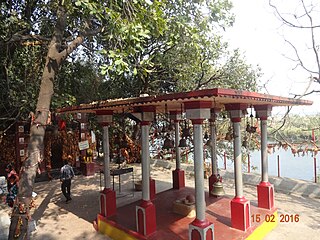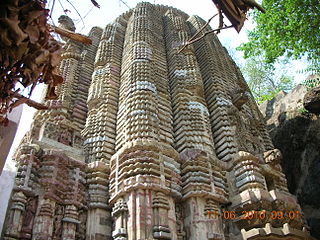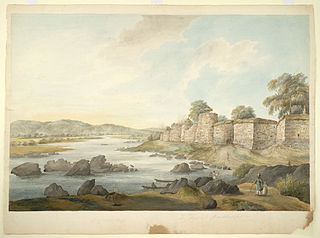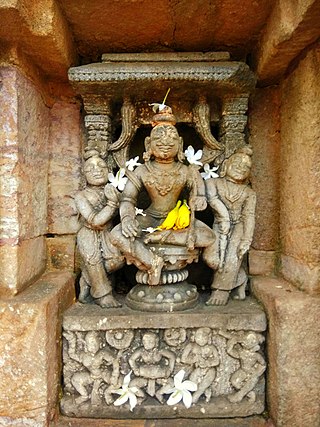
Bargarh is one of the major cities of Western Odisha and a municipality in Bargarh district in the state of Odisha in India. It is the administrative headquarters of Bargarh District and is the 13th largest city of Odisha by population.Bargarh was awarded with the "fastest moving city" award under the 50k-100k category in Swachh Survekshan 2022 in the east zone.

Sambalpur District is a district in the western part of state of Odisha, India. The historic city of Sambalpur is the district headquarters.

Bargarh District is an administrative district of Odisha state in eastern India. The city of Bargarh is its district headquarters. The district was carved out of the erstwhile district of Sambalpur on 1 April 1993.

Sambalpur is the fourth largest city in the Indian State of Odisha. It is located on the banks of river Mahanadi, with a population of 335,761. Prehistoric settlements have been recorded there. It is the home of the Sambalpuri sari.

Anangabhima Deva III was an Eastern Ganga monarch who ruled an early medieval Odisha-centered empire in eastern India from the year 1211 to 1238 CE. He maintained a large territory that stretched from the river Ganga in the north to Godavari in the south. He had defeated the Kalachuris on the western frontiers of the empire and established a matrimonial alliance with them. His brother or brother-in-law, Rajaraja II, became the ruler of the dynasty in 1198. When Anangabhima III came into power in 1211, he expelled the Muslims of Bengal from his kingdom. He had a son, Narasingha Deva I, who invaded Bengal in 1244 and captured the capital city, Gauda. He was a reformist in the social and spiritual structure of the Odia society as the vaishnavite deity Jagannath was declared as the supreme ruler of the empire and the emperor as the deputy under him. The Madala Panji records he claiming himself as Shri Purushottama dedicating everything to lord Jagannath. He built the famous Pradaskhina mandapa of Srikurmam temple.
The Gajapati Empire, was an empire established by the Suryavamsa dynasty or Routray dynasty, who were a medieval Hindu dynasty in the Indian subcontinent. It originated in the region of Trikalinga and reigned from 1434 to 1541 CE. It succeeded the reign of the Eastern Gangas. Under the Emperor Kapilendra Deva, the Gajapati empire stretched from lower Ganga in the north to Kaveri in the south.
Western Odisha is the western part of the state of Odisha in India, extending from the Kalahandi district in the south to the Sundargarh district in the north.

Patna State was a princely state in the Eastern States Agency of India during the British Raj. It had its capital at Balangir. Its area was 6,503 km2 (2,511 sq mi).

Gajapati Langula Narasingha Deva I was an Eastern Ganga monarch and a warrior of the Kalinga region who reigned from 1238 CE to 1264 CE. He defeated the Muslim forces of Bengal who constantly threatened the Eastern Ganga dynasty's rule over his kingdom of Kalinga from the times of his father Anangabhima Deva III. He was the first king from Kalinga and one of the few rulers in India who took the offensive against the Islamic expansion over India by Turko-Afghan invaders of Eastern India. His father had successfully defended his kingdom against the Turko-Afghan rulers of Bengal and crossed into Rarh, Gauda and Varendra in Bengal chasing the invaders on backfoot. He became the dominant ruler of the peninsula by defeating the Turko-Afgan, Gouda, and the powerful monarch of the south kakatiya Dynasty king Ganapati Deva, and was one of the most powerful Hindu rulers in India. He also built the Konark temple to commemorate his victories over the Muslims as well as other temples and the largest fort complex of Eastern India at Raibania in Balasore. He also built famous Varaha Lakshmi Narasimha Temple at Simhachalam, Andhra Pradesh. The Kendupatana plates of his grandson Narasingha Deva II mention that Sitadevi, the queen of Narasingha Deva I was the daughter of the Paramara king of Malwa.

Sambalpur is a district of Odisha. Sambalpur city is the headquarter of Sambalpur district. It is named after the presiding goddess Samaleshwari. Although it has prehistoric links and mythological mentions, the current settlement was established in the 14th century. Sambalpur is the cultural capital of Western Odisha.
Odisha, is an eastern Indian state on the Bay of Bengal. It is known for its tribal cultures and its many ancient Hindu temples. During the ancient times, many small kingdoms existed now known as Western Odisha, which was ruled by local chieftains.Western Odisha, or the western part of Odisha, India, extends from the Bolangir district in the south to the Sundargarh district in the north.

Kapilendra Deva was the founder of the Suryavamsa Gajapati Empire that ruled parts of eastern and southern India with the present-day Odisha as the center of the empire. He ascended to the throne after staging a military coup against the preceding and the last ruler from the Eastern Ganga dynasty, Bhanu Deva IV. He is also referred to as Kapilendra Routray or Sri Sri Kapilendra Deva. Kapilendra claimed descent from the Surya Vamsha of the Mahābhārata and was conferred the regnal title Shri Shri ...(108 times) Gajapati Gaudeshwara NabaKoti Karnata Kalabargeswara i.e. the Lord of Bengal (Gauda), the lord of the Karnataka region or Vijayanagara, the Lord of Kalaburagi and of nine crore subjects.

Sambalpur State, also known as Hirakhand Kingdom, was a kingdom founded in 1570. It ruled over Western Odisha and Eastern Chhattisgarh in central-eastern India prior to the Maratha occupation in 1800 AD. From 1849 AD, it was integrated with British Raj as a British District. Its capital was present-day Sambalpur city in Western Odisha.
The Jaya Chandrika, also known as the Jayachandrika, is a historical work composed in 1792 by Prahallad Dubey, the court poet of Sarangarh. It was written in the Lariya language for Chauhan, the ruler of Sambalpur.

Vira Pratapa Purushottama Deva was the second Gajapati emperor of Odisha who ruled from 1467 to 1497 C.E. He was the second ruler from the Suryavamsa Gajapati Empire. His father Gajapati Kapilendra Deva Routaraya chose him as his heir to rule the Gajapati Empire at the banks of river Krishna where he breathed his last. This decision infuriated his elder brother Hamvira Deva who was a battle hardened and successful warrior fulfilling the task of conquering the southern territories and expeditions against the Vijayanagara Empire as wished by his father.

Prataparudra Deva was the third Gajapati emperor of Odisha from the Suryavamsa Gajapati Empire founded by his grandfather Kapilendra Deva Routaraya. He reigned from 1497 to 1540 CE. Besides being a monarch, he was a devout Vaishnava and adherent of the famous saint, Sri Chaitanaya who arrived in Odisha during his reign. His life was extremely occupied with overwhelming military campaigns in defense of his inherited territory from three frontal invasions by the enemy states Vijayanagar, Hussain Shahi dynasty of Bengal and Turko-Persian Qutb Shahi dynasty of Golconda. He lost large portions of his territory to the neighboring enemy states initiating the dissolution of Odisha's military hegemony and imperial status that continued for nearly a period of 600 years before him.
Ramai Deva or Ramai Deo was a Rajput ruler who founded the Chauhan Dynasty rule in the erstwhile Patna state in today’s Bolangir district of Odisha in the year 1360 A.D. At the young age of twenty he staged a coup with the popular support of the commoners and overtook the Astha Mullicks or the eight regional Gauntias ruling as independent warlords in oligarchy after the Eastern Ganga administrator of the region died. The central control of the Gangas had nearly collapsed due to outside invasions. As an energetic and remarkable leader, he established his firm control of the erstwhile Patna state Odisha that might have included some parts of Chatishgarh as well.
Jagannatha Gajapati Narayana Deo II was the Odia monarch of the Paralakhemundi Estate in the southern part of today's Odisha and northern Andhra Pradesh. He was from the Eastern Ganga dynasty of the Khemundi Ganga Branch from the year 1736 CE to 1771 CE. He had ascended to the throne at the age of eighteen and at a time when Odisha was torn apart due conflicts between external powers like the Mughals, Marathas, French and British for control of the territory. He invaded khurdha Bhoi dynasty king Birakishore Deva and Vizianagaram estate King Pusapati Vijayarama Raju II and defeated the both kings. He made the last great attempts on his own to revive the lost glory of Odisha and its unique Hindu culture that revolved around the tradition of Jagannath worship. He had defied the authority of the Nizam of Hyderabad and maintained his own sovereignty. He was one of the first rulers who indulged in conflicts with the new European colonists in the eastern part of India. He was also effort bound till the end of his life in framing strategic diplomatic plans to free the ancient land of Odisha from external aggressors and revival of its lost Eastern Ganga Dynasty-Gajapati glory from the past.

The Bhoi dynasty or the Yaduvamsa dynasty were a medieval Hindu dynasty from the Indian subcontinent, which originated in the region of Odisha that reigned from 1541 to 1560 CE. Govinda Vidyadhara had usurped the throne from the later weaker Suryavamsa Gajapati Empire rulers as the kingdom started weakening but had a short-lived reign as ruling chiefs of Odisha as the ensuing internal rivalries and constant threats of invasions rendered them weak and were eventually overthrown by Mukunda Deva of Chalukya dynasty in 1560.












